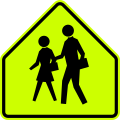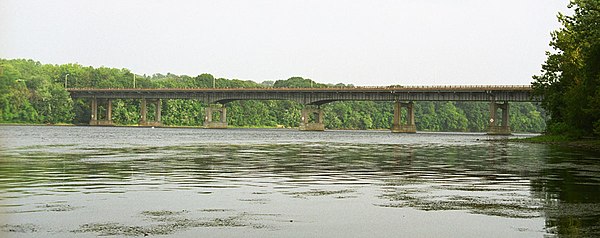Portal:Connecticut
The Connecticut Portal

Connecticut (/kəˈnɛtɪkət/ ⓘ kə-NET-ik-ət) is the southernmost state in the New England region of the Northeastern United States. It borders Rhode Island to the east, Massachusetts to the north, New York to the west, and Long Island Sound to the south. Its capital is Hartford, and its most populous city is Bridgeport. Connecticut lies between the major hubs of New York City and Boston along the Northeast Corridor, where the New York metropolitan area, which includes six of Connecticut's seven largest cities, extends well into the southwestern part of the state. Connecticut is the third-smallest state by area after Rhode Island and Delaware, and the 29th most populous with slightly more than 3.6 million residents as of 2020, ranking it fourth among the most densely populated U.S. states.
The state is named after the Connecticut River, the longest in New England which roughly bisects the state and drains into the Long Island Sound between the towns of Old Saybrook and Old Lyme. The name of the river is in turn derived from anglicized spellings of Quinnetuket, a Mohegan-Pequot word for "long tidal river". Before the arrival of the first European settlers, the region was inhabited by various Algonquian tribes. In 1633, the Dutch West India Company established a small, short-lived settlement called House of Hope in Hartford. Half of Connecticut was initially claimed by the Dutch colony New Netherland, which included much of the land between the Connecticut and Delaware Rivers, although the first major settlements were established by the English around the same time. Thomas Hooker led a band of followers from the Massachusetts Bay Colony to form the Connecticut Colony, while other settlers from Massachusetts founded the Saybrook Colony and the New Haven Colony; both merged into the former by 1664.
Connecticut's official nickname, the "Constitution State", refers to the Fundamental Orders adopted by the Connecticut Colony in 1639, which is considered by some to be the first written constitution in Western history. As one of the Thirteen Colonies that rejected British rule during the American Revolution, Connecticut was influential in the development of the federal government of the United States. In 1787, Roger Sherman and Oliver Ellsworth, state delegates to the Constitutional Convention, proposed a compromise between the Virginia and New Jersey Plans; its bicameral structure for Congress, with a respectively proportional and equal representation of the states in the House of Representatives and Senate, was adopted and remains to this day. In January 1788, Connecticut became the fifth state to ratify the Constitution. (Full article...)
On July 23, 2007, Linda Hayes (named as Steven Hayes and presenting as male at the time of the incident) and Joshua Komisarjevsky invaded the residence of the Petit family in Cheshire, Connecticut. Though initially planning only to rob the house, Hayes and Komisarjevsky murdered Jennifer Hawke-Petit and her two daughters, 17-year-old Hayley Petit and 11-year-old Michaela Petit. Their father, Dr. William Petit, escaped with severe injuries.
Upon entering the Petits' home, Komisarjevsky beat William with a baseball bat, and the pair restrained him in the basement. Hawke-Petit and her daughters were also restrained. Hayes later kidnapped Hawke-Petit and forced her to withdraw money at a bank. After returning to the home, Hayes raped Hawke-Petit and strangled her to death. Komisarjevsky raped 11-year-old Michaela. The invaders then decided to burn down the house to destroy evidence. With Hayley and Michaela tied to their beds, the invaders doused them and the house with gasoline and set it on fire, leaving them to die of smoke inhalation. (Full article...)General images -
Selected picture -
State facts
- Nicknames: The Provisions State, The Land of Steady Habits, The Constitution State, The Nutmeg State
- Capital: Hartford
- Governor: Ned Lamont (D)
- Lieutenant Governor: Susan Bysiewicz (D)
- Secretary of State: Stephanie Thomas (D)
- Attorney General: William Tong (D)
- Senators: Chris Murphy (D), Richard Blumenthal (D)
- Representatives: Jahana Hayes (D), Jim Himes (D), Joe Courtney (D), John B. Larson (D), Rosa DeLauro (D)
- Total area: 5,543 mi2
- Land: 4,845 mi2
- Water: 698 mi2
- Highest elevation: 2,379 ft (Mount Frissell)
- Population 3,576,452 (2015 est)
- Admission to the Union: January 9, 1788 (5th)
State symbols:
- Animal: Sperm whale
- Bird: American Robin
- Fish: American Shad
- Flower: Mountain Laurel
- Fossil: Dinosaur Track
- Insect: European Praying Mantis
- Ship: USS Nautilus (SSN-571)
- Songs: Yankee Doodle
- Tree: Charter Oak
- Mineral: Almandine
Selected article -
The Merritt Parkway (also known locally as "The Merritt") is a controlled-access parkway in Fairfield County, Connecticut, with a small section at the northern end in New Haven County. Designed for Connecticut's Gold Coast, the parkway is known for its scenic layout, its uniquely styled signage, and the architecturally elaborate overpasses along the route. As one of the first, oldest parkways in the United States, it is designated as a National Scenic Byway and is also listed in the National Register of Historic Places. Signed as part of Route 15, it runs from the New York state line in Greenwich, where it serves to continue the Hutchinson River Parkway, to Exit 54 in Milford, where the Wilbur Cross Parkway begins. Facing bitter opposition, the project took six years to build in three different sections, with the Connecticut Department of Transportation constantly requiring additional funding due to the area's high property value. The parkway was named for U.S. Congressman Schuyler Merritt. In 2010, the National Trust for Historic Preservation called the Merritt Parkway one of "America's 11 Most Endangered Historic Places".
Trucks, buses, trailers, towed vehicles, and all vehicles 8 feet (2.4 m) tall or taller are not allowed on any part of the parkway due to its low bridges, narrow lanes, and tight curve radii. (Full article...)Did you know? -
- ... that after her father received hospice care, Connecticut state legislator Claudia Powers introduced bills to include hospice under Medicare?
- ... that a Connecticut radio station was "the loser in a survival-of-the-fittest battle"?
- ... that Darien, Connecticut, was once home to a train station built inside a cemetery?
- ... that the Connecticut Valley Railroad successfully fooled the New York, New Haven and Hartford Railroad into purchasing it by pretending that it planned to expand northwards?
- ... that Cora Slocomb di Brazza designed the peace flag adopted by the International Council of Women, and her mother Abby Day Slocomb designed the Connecticut state flag?
- ... that the home of civil rights activist Lottie B. Scott is a stop on Norwich's Freedom Trail?
In the news

- February 10: Disney to shut down Blue Sky Studios, animation studio behind 'Ice Age'
- October 17: Hundreds arrested for 'dark web' child porn by international task force
- October 3: World War II era plane crashes in Connecticut, US, killing at least seven
- February 21: Sixteen states sue U.S. President Trump to stop declaration of emergency for border wall
Categories
Related WikiProjects

WikiProject Connecticut • WikiProject Connecticut routes • WikiProject UCONN
Selected panorama
Topics
Related portals
Associated Wikimedia
The following Wikimedia Foundation sister projects provide more on this subject:
-
Commons
Free media repository -
Wikibooks
Free textbooks and manuals -
Wikidata
Free knowledge base -
Wikinews
Free-content news -
Wikiquote
Collection of quotations -
Wikisource
Free-content library -
Wikiversity
Free learning tools -
Wikivoyage
Free travel guide -
Wiktionary
Dictionary and thesaurus


























































